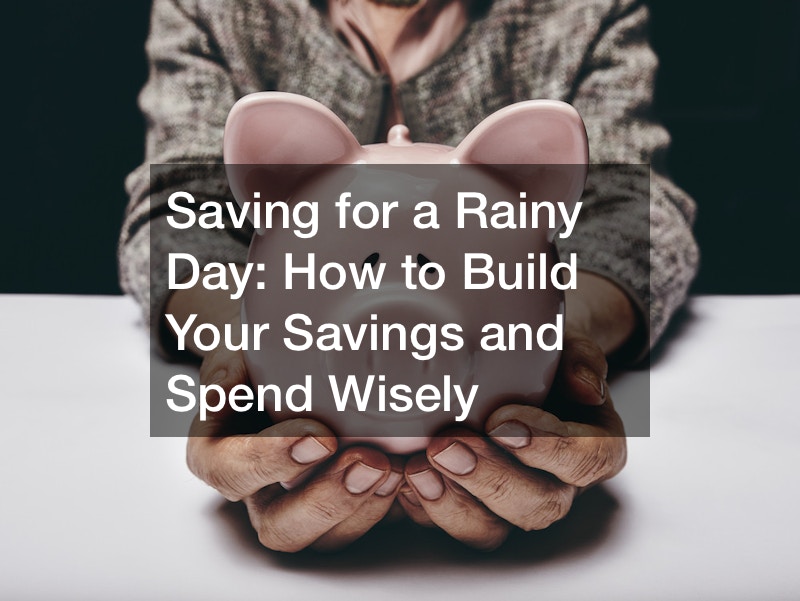
A rainy day fund can add a layer of protection to your nest egg. And it’s essential for everyone, regardless of your life stage or net worth. Remember, your rainy day is bound to come, whether it’s the next hour, tomorrow, or a year from now. And when it comes, you want adequate cash to cater for the unexpected expense. So how do you build your rainy day savings and spend wisely? Here’s your detailed guide.
What is a Rainy Day Fund?

A rainy day fund might feel like money meant for the rains or something like floods. But it’s not. Instead, these are savings you set aside for unexpected and lower-cost expenses like purchasing trailer parts or parking tickets. Think of it like money that you set aside for specific future expenses.
However, don’t confuse a rainy day fund with an emergency fund—they differ in terms of size and their use. For instance, a rainy day fund is meant for smaller unexpected expenses, like car coating or buying new tires.On the other hand, an emergency fund is meant for unanticipated events or significant life changes like a job loss or accidents that can influence your income and finances significantly. However, you need both a rainy fund and an emergency fund to stay protected from whatever life throws your way.
The Importance of Saving for a Rainy Day
Life’s little challenges, if not addressed on time, can quickly snowball into massive crises. That’s why you need to save some extra cash, just in case life decides to play a game with you. Experts say you should have about $500-$2000 in your rainy day fund. However, this can vary depending on individual circumstances. Therefore, you want to assess your financial situation and decide the right savings for you and your family.
Unfortunately, most people—around 78% of U.S. workers- live paycheck to paycheck. Therefore, the last thing they want to do is save. The little they have or earn does not suffice to cater to their expenses fully. But this should not be a reason for you not to save. With the right discipline and commitment, you can save enough for rainy days. Here’s what having a rainy day fund means;
Minimal Financial Stress
You’ll always be stressed if you don’t have money to cater to your expenses or unexpected events. Unfortunately, this can wreak havoc on your physical and mental health. However, you can find comfort in a rainy day fund. Having this provides stability and peace of mind.
Avoid Debt

What happens when you need to visit an emergency pediatric dentist but have no money? You’ll think of borrowing, right? High-interest debt like personal loans or credit cards should never be an option for covering unplanned costs.
But this is, unfortunately, what most of you do when faced with emergency financial challenges like tooth loss. A well-stocked rainy day fund helps you prevent high-interest debts.
You Have Options
No matter your life challenges, money will always give you options, in plenty. This explains the importance of saving for a rainy day. So, when facing unexpected situations like a local stucco repair, you’ll always have enough cash to explore other options, like a replacement.
How to Build Your Rainy Day Fund
Saving is wise for anyone who thinks about the future, not the present. Regardless of your financial situation, you must save money because you never know what tomorrow brings. But remember, anything that involves money requires adequate planning and good discipline. So, now that you’ve decided to save for a rainy day, let’s get you started.
Determine the Amount of Money You Need in Your Rainy Day Fund

Although experts recommend having around $500 to $2500 in your rainy day fund, the exact amount varies from individual to individual. For instance, the amount will be higher if you earn more. Also, you must save more if your anticipated rainy day expenses are more.
So, first, consider what expenses you might need to pay with the rainy day fund. For instance, if you need a Medicaid legal service, how much will you pay for the service? Typically, this step involves deciding the expenses guaranteeing a rainy day fund use. They include;
- Medical bills costing more than you expected
- Unexpected home repairs
- Major appliances that have broken
- Unexpected vehicle repair
Once you know the expenses your rainy day fund should cover, you should now start saving.
Assess Your Personal Needs
The amount you’ll have in your rainy day fund will vary based on your needs and earnings. Therefore, before you start saving, take some time to assess your financial situation and personal needs. For instance, someone who owns a car might need to save more for emergency vehicle repairs than someone without a car.
While assessing your needs, consider your total cash flow, financial goals, debt, and expenditure. Once you understand your financial standing, you can now budget for a rainy day.
Create a Budget

A proper budget is essential for creating and building a rainy day fund. Many people think they can’t save for rainy days because they don’t earn enough money. But it’s all about budgeting. You must budget and spend wisely to build your savings. So, sit down and analyze your cash flow—you’ll realize you have enough money to save for a rainy day and still meet your essential expenses.
Experts recommend a 50-30-20 rule when budgeting for a rainy day. The 20% s of your earnings should go to savings. Divide the amount into several portions depending on your saving goals and needs. Generally, you should stick to your budget to limit unnecessary purchases. Also, learn to spend wisely and save any extra earnings you make.
Open a Separate Savings Account for a Rainy Day Fund
Now it’s time to decide where your rainy day fund will sit. First, we recommend keeping your rainy day fund in a credit union or bank savings account. We assume you already have a savings account for emergencies and other types of savings. However, you should not mix your savings in one account. Instead, open a separate savings account specifically for rainy day funds.
The good thing about savings accounts is that they offer low risk, and you can access your funds quickly. Opt for a high-yield savings account to grow your fund faster. Keep in mind that while you might want your rainy day funds to be accessible, they should be away from temptation. This means you shouldn’t use your rainy day fund for other expenses or purposes.
Start Saving
Now that everything is set, you should now start saving for a rainy day. You should continuously and consistently save for your rainy day fund. Knowing you have enough money to cover your unexpected expenses will provide peace of mind.
Tips on Saving Money for a Rainy Day
It’s easier to open a savings account and decide to save for a rainy day. However, many people don’t have the saving discipline. Therefore, they can’t maintain a saving habit. Some of you don’t know how to spend wisely—and this is what prevents them from achieving their saving goals. We want to help you build your rainy day funds to prepare for unexpected expenses. Here are some tips you might find helpful.
Automate Your Savings
What is the first thing you do when you receive your salary? Some will pay their rent. Others will rush to pay school fees or buy other essential needs. However, the first thing you need to do when you receive your salary is to pay yourself. But how do you pay yourself when in reality, you’ve been paid, and the money is yours?
Paying yourself means setting aside a portion of your salary into a separate account, commonly a savings account. However, most people don’t pay themselves first when they receive their salaries. And it’s understandable because your needs are essential.
However, we have a trick to help you maintain consistency in your savings—automate your savings. Automating your savings allows you to contribute regularly and consistently to your savings account. This way, you won’t forget or procrastinate on saving money for a rainy day because you won’t even need to do so—it will be done automatically. Also, you won’t need to decide whether to save or spend money when your salary hits your account.
Track Your Expenses
As a rule of thumb, you should always spend wisely, whether you earn six figures or live paycheck to paycheck. But how do you ensure you spend wisely? First, you must track your expenses. Start by identifying all your expenses, then group them into essential, not-so-essential, and non-essential expenses.
Necessary expenses may include rent, food, school fees, and costs for local rehab therapy. Any expense that you can live comfortably without is a non-essential expense. Therefore, consider cutting back on some non-essential expenses like a Netflix subscription you don’t use. Analyze your spending patterns and make adjustments as needed. Then, save the extra cash for a rainy day.
Save Windfalls and Bonuses
What do you do with any unexpected money you receive? Some will splurge when they receive bonuses, tax refunds, or cash gifts. While you may want to treat yourself with this unexpected money, the rule remains—spend wisely.
For instance, you can spend these monies on essential expenses like a French drain replacement or any other essential expense. However, don’t spend everything on unnecessary expenses. Consider saving some of the bonuses or tax refunds for a rainy day. It’s an excellent way to build your savings.
Comparison Shop
You should always spend wisely, especially when making massive purchases. Don’t always go with the first option you find. For instance, if you’re looking for a roofer to help you repair or maintain your roof, get quotes from multiple roofers first.
If it’s a tummy tuck surgery, get quotes from multiple hospitals before paying for the service. The prices vary significantly depending on where you buy a product or service. However, this doesn’t mean you should settle for less—instead, it’s about affordability.
Before making significant purchases, research and compare prices, quality, and reviews. Look for discounts, deals or consider buying second-hand items when appropriate. Taking time to make informed decisions will save you money in the long run. Reserve the money saved into your savings account for a rainy day.
Avoid Impulse Buying
Most of us waste a lot of money from impulse buying. According to various sources, approximately 54% of U.S. shoppers admit to spending over $100 on an impulse buy. Women are more likely to engage in impulse buying than men. Unfortunately, this behavior can cause financial strain, feelings of guilt, and regret, among other adverse outcomes. What’s more, they could affect your rainy day fund.
Therefore, try to spend wisely and resist impulse purchases. For instance, if you feel like buying something, don’t buy it immediately. Instead, wait a day or two to cool off and evaluate the purchase. If you still feel the purchase is worth it, you can buy it after this period. If not, use the money for another essential expense or, better, save the money for a rainy day.
Prioritize Value and Quality
When buying durable items like electronics or vehicle spares, prioritize quality and value over price. While you may have to pay more for quality, long-lasting items, you’ll save more in the long term. This is because you won’t need frequent repairs or replacements. Therefore, always purchase well-made and quality items from reputable brands or sources.
Saving for a rainy day is among the wisest financial decisions you can ever make. The savings can cushion you in case of unexpected events like home renovations, vehicle repairs, and emergency medical bills. However, you should understand the difference between an emergency fund and a rainy day fund. A rainy day fund is for smaller unexpected expenses like buying vehicle parts or replacing a home appliance. When saving for a rainy day, spend wisely and avoid unnecessary expenses.



